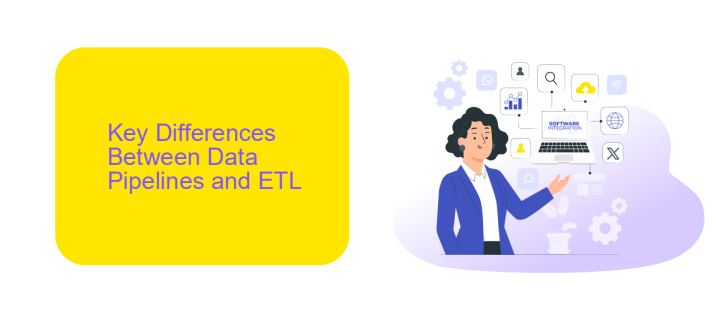Data Pipeline vs ETL
In the realm of data processing, understanding the distinction between data pipelines and ETL (Extract, Transform, Load) processes is crucial. While both serve to move and transform data, they are not interchangeable. This article delves into the unique characteristics, use cases, and advantages of data pipelines versus ETL, helping you choose the right approach for your data needs.
Introduction to Data Pipeline and ETL
Data pipelines and ETL (Extract, Transform, Load) are essential components in modern data management. While both aim to facilitate the movement and transformation of data, they serve slightly different purposes and can be implemented in various ways to meet organizational needs.
- Data Pipeline: A series of processes that move data from one system to another, often involving real-time data streaming and complex transformations.
- ETL: A specific type of data pipeline that focuses on extracting data from various sources, transforming it into a suitable format, and loading it into a target database or data warehouse.
Understanding the distinctions between data pipelines and ETL is crucial for optimizing data workflows. Services like ApiX-Drive can simplify the integration process by automating data transfers and transformations, ensuring seamless connectivity between disparate systems. Whether you're dealing with real-time data streams or scheduled batch processes, choosing the right approach can significantly impact your data strategy.
Key Differences Between Data Pipelines and ETL

Data pipelines and ETL processes serve distinct purposes in data management. Data pipelines are end-to-end systems that transport data from various sources to destinations, often in real-time. They handle continuous data flows and support complex data transformations, making them suitable for dynamic environments. ETL (Extract, Transform, Load), on the other hand, is a structured process that extracts data from sources, transforms it into a suitable format, and loads it into a destination, typically a data warehouse. ETL processes are batch-oriented and usually run at scheduled intervals, making them ideal for static data environments.
Another key difference lies in their flexibility and integration capabilities. Data pipelines offer greater flexibility, enabling seamless integration with various data sources and destinations. Tools like ApiX-Drive facilitate these integrations by providing a user-friendly platform to connect different services without extensive coding. ETL processes, while robust, are less flexible and often require significant manual intervention to integrate new data sources or adapt to changes. This makes data pipelines more adaptable to evolving business needs and technological advancements.
Advantages and Disadvantages of Data Pipelines and ETL

Data pipelines and ETL processes are essential in managing and transforming data within organizations. Each has its own set of advantages and disadvantages that can influence their effectiveness in different scenarios.
- Data Pipelines
- Advantages: Real-time data processing, scalability, and flexibility in integrating various data sources.
- Disadvantages: Complexity in setup and maintenance, higher costs, and potential latency issues.
- ETL (Extract, Transform, Load)
- Advantages: Structured data transformation, reliability, and ease of use for batch processing.
- Disadvantages: Limited real-time capabilities, rigidity in handling diverse data sources, and potential performance bottlenecks.
Choosing between data pipelines and ETL depends on the specific needs of your organization. For instance, if you require real-time data integration, a data pipeline might be more suitable. On the other hand, ETL is ideal for structured batch processing. Tools like ApiX-Drive can simplify integration processes, making it easier to connect and automate data flows regardless of the method chosen.
When to Use Data Pipelines or ETL

Choosing between data pipelines and ETL largely depends on your specific data needs and infrastructure. If your organization requires real-time data processing and seamless integration across various platforms, data pipelines are the ideal choice. They offer flexibility and scalability, allowing for continuous data flow and immediate insights.
On the other hand, ETL (Extract, Transform, Load) is best suited for batch processing and scenarios where data needs to be periodically moved from one system to another. ETL processes are robust for handling large volumes of data and performing complex transformations before loading data into a data warehouse.
- Use data pipelines for real-time analytics and continuous data integration.
- Opt for ETL when dealing with large, periodic data transfers and complex transformations.
- Consider hybrid approaches for scenarios requiring both real-time and batch processing.
For seamless integration and automation of your data workflows, consider using services like ApiX-Drive. It simplifies the process of connecting various applications and automating data transfers, ensuring efficient and reliable data management.
Conclusion
In conclusion, both Data Pipelines and ETL processes play crucial roles in data management and integration. Data Pipelines offer a more flexible and scalable solution, enabling real-time data processing and seamless integration with various data sources. On the other hand, ETL processes are well-suited for batch processing and structured data transformation, making them ideal for traditional data warehousing needs.
Choosing between Data Pipelines and ETL depends on your specific requirements and the nature of your data. For businesses looking to streamline their data integration processes, services like ApiX-Drive can be invaluable. ApiX-Drive simplifies the connection between different applications and automates data workflows, ensuring efficient and reliable data transfer. Ultimately, understanding the strengths and limitations of each approach will help you make an informed decision that aligns with your organizational goals.
FAQ
What is the main difference between a Data Pipeline and ETL?
Can ETL be considered a part of a Data Pipeline?
What are the common use cases for Data Pipelines?
How can I automate and integrate Data Pipelines and ETL processes?
Why is it important to monitor Data Pipelines and ETL processes?
Apix-Drive is a universal tool that will quickly streamline any workflow, freeing you from routine and possible financial losses. Try ApiX-Drive in action and see how useful it is for you personally. In the meantime, when you are setting up connections between systems, think about where you are investing your free time, because now you will have much more of it.

